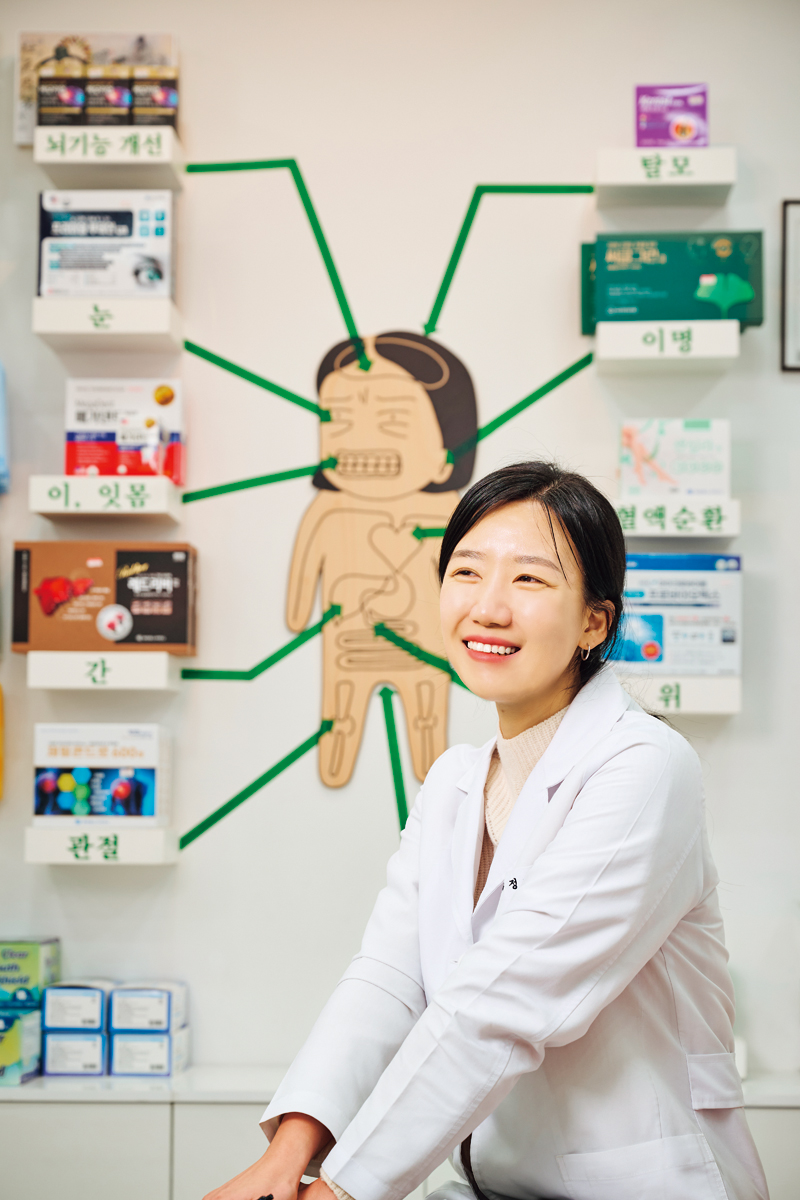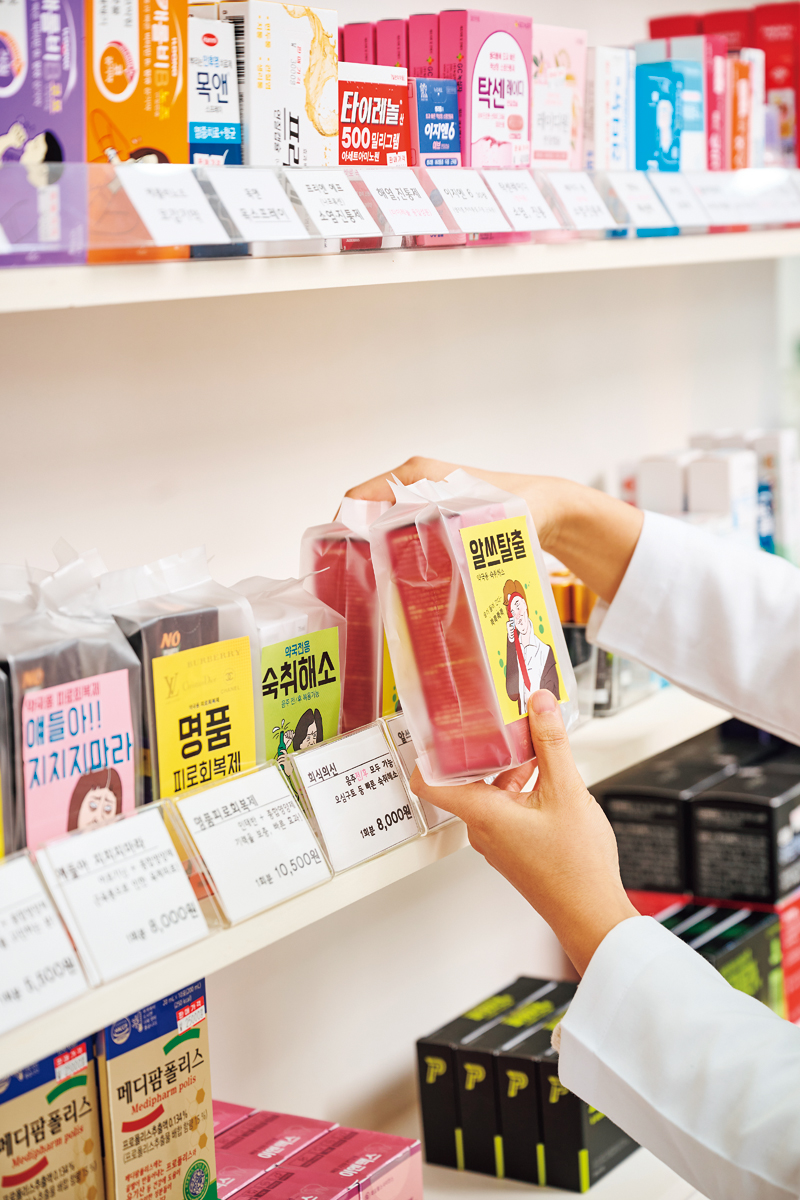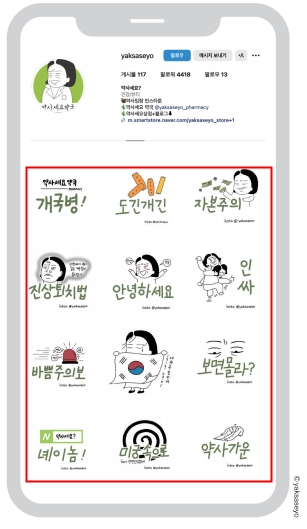Besides filling pres
criptions and dispensing health tips, Jeong Cho-rong oversees a bustling parade of customers who just want to sit and talk with friends. Her pharmacy brings to mind a
sarangbang, the type of community meeting spot that is becoming increasingly rare.

Jeong Cho-rong’s small pharmacy in Yeongwol serves as a neighborhood meeting spot, where senior citizens chat, passengers wait for the bus, and people drop off their bags before running errands.
Jeong Cho-rong’s day is simple but also quite busy. From 9 a.m., when she opens her pharmacy, to closing time at 6 p.m., she fills prescriptions, dispenses healthcare advice, makes notes about her customers’ conditions, and designs her own marketing material.
She also manages a task entirely unrelated to her profession: watching over customers’ shopping bags and other belongings while they run errands. Regulars often entrust her with their groceries from a nearby market, while they dash over to their bank, doctor, government office, or retail store.
“The on the faces of these aunties when they ask if I would look after their things for a bit, it’s really adorable. It makes me even more thankful that they feel so comfortable in this space. This is exactly what I hoped would happen,” Jeong explains.
GO-TO SPOT
The reception room in a traditional Korean home is called sarangbang, which literally means “love room.” Outside the home, a sarangbang is an informal community meeting spot where residents swap stories, information, and ideas, or just rest and relax.
Nowadays, the neighborhood sarangbang is becoming extinct, pushed aside by the forces of urbanization. But in rural towns, where the pace is slower, the traditional sarangbang is still visible.
In Yeongwol, Jeong’s small hometown in Gangwon Province, her conscious effort to make her rural pharmacy into something more than a source of medicine and healthcare products has given it a secondary role. The pharmacy has a table where customers can sit while waiting for their medication. It offers a rotation of snacks, including perennial Korean favorites, such as ssanghwatang, a Korean herbal drink that relieves fatigue and staves off colds; yakgwa, traditional Korean honey cookies; and candies, vitamins, and gum.
Ostensibly a waiting area, many customers use the table for entirely different ends. They take a break before meeting friends nearby, or simply pass the time until the bus comes to take them home. People stop by to rest and talk, like they would in the shade of a big village tree. The pharmacy, thus, plays the role of a neighborhood sarangbang. Its location on a busy street enhances its accessibility and its floor-to-ceiling window front gives it an inviting atmosphere.
HOMETOWN HAPPINESS
Yeongwol is nestled in the southern part of Gangwon Province amid a dazzling backdrop of mountains, valleys, rivers, and lakes. After Jeong finished her pharmaceutical studies, she worked for about a year at a pharmacy in Chungju, a city in North Chungcheong Province. “It was physically demanding because it was a very busy pharmacy with no time to rest, but I was able to learn a lot, since patients required a wide range of different medications. It was one of the most gratifying periods in my career as a pharmacist.” The experience prompted her to reexamine her priorities. “I was so busy processing wave after wave of prescriptions that I couldn’t even properly explain the medicine to customers. And then one day it struck me: I wanted to really interact with them instead of just filling prescriptions like some robot. So, I decided to open my own pharmacy.”
After leaving her job in Chungju, Jeong took a three-month break to travel solo. Handling all types of situations on her own gave her the confidence for the next step in her career.
In Chungju, Jeong couldn’t find a place that suited her, but in Yeongwol, a site became available that had been a clothing store for over 30 years. When her father told her about the vacancy, she was initially apprehensive. She had never considered returning to the countryside to be a rural pharmacist, but her perspective soon changed. What place could be better suited to creating a warm, welcoming pharmacy than her own hometown? Jeong returned in April 2019 and opened Yaksaseyo Pharmacy (literally “Please Buy Medicine Pharmacy”), becoming a 29-year-old business owner just two years after getting her pharmacist license. Her instincts were spot on; her new customers, who already knew her entire family, embraced her as one of their own.
“The COVID-19 chaos hit less than a year after we opened,” she recalls. “That wasn’t easy, dealing with mask shortages and painkillers running out, but ultimately I think going through all that together d a stronger bond with our local customers.”
Now that things are back to normal, Jeong has noticed a shift in which medicines sell well. Before, medicines to treat illnesses were popular, but these days, sales of preventative medicines have increased — a marker of the greater awareness of the importance of immunity.
Jeong is fastidious about knowing and keeping a record of each customer’s medical history. The better she knows them, the more she can help. “Since I was young, I felt pride when I volunteered or donated to a cause,” Jeong says. “I thought that if I became a pharmacist, I could share my expertise with many people, and if it helped them, it would be the perfect job for me.”
BIG DOSES OF EMPATHY
“Most of our customers are regulars, so sometimes I find myself giving advice on their family’s health issues as well as their own. I try to be as detailed as possible with my explanations, so that I can help everyone who visits my pharmacy, and their families, live even slightly healthier lives.”
In Korea, people often consult their pharmacist for simple diagnoses and medication even without seeing a doctor. In rural areas without many hospitals or clinics, pharmacies inevitably play an even bigger role in non-emergency situations.

Jeong applies stickers of her own design to packages of medicines for hangovers, fatigue, and other symptoms.
In Yeongwol County, where elderly people easily outnumber the young, a local pharmacist’s guidance is particularly important. “I think pharmacists are the easiest experts for patients to meet. They don’t require appointments or charge anything for quick consultations. It’s very gratifying that people who need me for whatever reason can drop by my pharmacy any time.”
Jeong carefully asks her customers about their symptoms, diet, and medications. Every time a patient’s health improves thanks to her expertise, she experiences it as a moment of personal growth. The young pharmacist also adds a large dose of empathy when she fills prescriptions and offers advice.
“There are lots of moments I’ll never forget. One day, I was talking to a middle-aged woman who’d come in wearing a hat, and it turned out that she was going through chemotherapy. I wanted to somehow give her courage, so I squeezed her hand real tight — and I just burst into tears. And even though all I could do in that moment was hold her hand, I remember she was so grateful. Now she’s in remission, and she comes into the pharmacy looking totally healthy; I feel so fond of her every time I see her.”
Jeong also remembers a middle-aged woman who asked about nutritional supplements for dementia. She revealed that her mother had it and would be going to a nursing home soon. That was another day that Jeong cried with her customer. While empathy is not a cure, she believes it can give someone the strength to rally once again. That motivates Jeong to spend so much time and energy listening and empathizing. She still remembers the smile on that customer’s face after they shared tears.
HEALING WITH LAUGHTER
Through the pharmacy’s large windows, framed by trees, Jeong can witness the passage of time. Another reminder of the changing seasons are the assortments of fruits and vegetables packed in bags temporarily entrusted to her.

Jeong is currently serializing a webtoon on social media using characters of her own creation. The storylines range from how she opened her pharmacy to the types of customers she sees and the best medicine to use.
© yaksaseyo
When the pace slows, Jeong designs posters for her pharmacy, or stickers for products like energy boosters. Her shop is dotted with charming little scenes. Upon entering, customers immediately see a cartoon character with visible organs like the brain, eyes, liver, and stomach. This character is the protagonist of a webtoon that Jeong started for fun on social media (www.instagram.com/ yaksaseyo_pharmacy) back when she was working in Chungju. Trying to come up with a way to be more approachable for her customers, she d the character based on herself and stuck the relevant organs and corresponding medications on the wall. Her stickers are just as witty. She places them on the hangover cures and fatigue remedies, and her customers love them.
“These days, I’m serializing a cartoon in Yeongwol Living, a monthly newsletter published by the county. The stories are about small things that happen in the pharmacy. I hope they give my readers a chuckle or two.”
Slowly, the sun starts to set. Jeong heads home after a day of dispensing medicine and advice, all with her signature warmth in her community space. Back home, she settles in to finish the witty designs and comics she worked on during the day — and before she knows it, night has fallen.